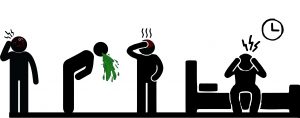17.4 Palliative Care Management
Open Resources for Nursing (Open RN)
Now that we have discussed basic concepts and the nursing process related to the grieving process, let’s discuss more details regarding providing palliative care. Nurses provide palliative care whenever caring for clients with chronic disease. As the disease progresses and becomes end-stage, the palliative care they provide becomes even more important. As previously discussed in the “Basic Concepts” section, palliative care is client and family-centered care that optimizes quality of life by anticipating, preventing, and treating suffering. Palliative care occurs throughout the continuum of care and involves the interdisciplinary team collaboratively addressing physical, intellectual, emotional, social, and spiritual needs and facilitating client autonomy, access to information, and choice.”[1]
Providing care at the end of life is similar for clients with a broad variety of medical diagnoses. It addresses multiple dimensions of care, including physical, psychological, social, and spiritual aspects:
- Physical: Functional ability, strength/fatigue, sleep/rest, nausea, appetite, constipation, and pain
- Psychological: Anxiety, depression, enjoyment/leisure, pain, distress, happiness, fear, and cognition/attention
- Social: Financial burden, caregiver burden, roles/relationships, affection, and appearance
- Spiritual: Hope, suffering, the meaning of pain, religiosity, and transcendence[2]
The interdisciplinary team manages pain and other symptoms, assists with difficult medical decisions, and provides additional support to clients, family members, and caregivers. Nurses have the opportunity to maintain hope for clients and family members by providing excellent physical, psychosocial, and spiritual palliative care. Nursing interventions begin immediately after the initial medical diagnosis and continue throughout the continuum of care until the end of life. As a client approaches end-of-life care, nursing interventions include the following:
- Eliciting the client’s goals for care
- Listening to the client and their family members
- Communicating with members of the interdisciplinary team and advocating for the client’s wishes
- Managing end-of-life symptoms
- Encouraging reminiscing
- Facilitating participating in religious rituals and spiritual practices
- Making referrals to chaplains, clergy, and other spiritual support[3]
While providing palliative care, it is important to remain aware that some things cannot be “fixed”:
- We cannot change the inevitability of death.
- We cannot change the anguish felt when a loved one dies.
- We must all face the fact that we, too, will die.
- The perfect words or interventions rarely exist, so providing presence is vital.[4]
The Palliative Care Network of Wisconsin contains excellent resources for nurses providing care for seriously ill clients.
View the “Fast Facts” page for extensive information about palliative care and end-of-life topics.
Management of Common Symptoms
Many clients with serious, life-limiting illnesses have common symptoms that the nurse can assess, prevent, and manage to optimize their quality of life. These symptoms include pain, dyspnea, cough, anorexia and cachexia, constipation, diarrhea, nausea and vomiting, depression, anxiety, cognitive changes, fatigue, pressure injuries, seizures, and sleep disturbances. Good symptom management improves quality of life and functioning at all states of chronic illness. Nurses play a critical role in recognizing these symptoms and communicating them to the interdisciplinary team for optimal management. The plan of care should always be based on the client’s goals and their definition of quality of life.[5] These common symptoms are discussed in the following subsections.
Pain
Pain is frequently defined as “whatever the experiencing person says it is, existing whenever they say it does.”[6] When a client is unable to verbally report their pain, it is important to assess nonverbal and behavioral indicators of pain. The goal is to balance the client’s desire for pain relief, along with their desire to manage side effects and oversedation. There are many options available for analgesics. Reassure a client that reaching their goal of satisfactory pain relief is achievable. Read more about pain management in the “Comfort” chapter. See Figure 17.18[7] for an image illustrating a client experiencing pain.

Dyspnea
Dyspnea is a subjective experience of breathing discomfort and is the most reported symptom by clients with life-limiting illness. Dyspnea can be extremely frightening. Assessing dyspnea can be challenging because the client’s respiratory rate and oxygenation status do not always correlate with the symptom of breathlessness.[8] See Figure 17.19[9] for an image of a client depicting chest pain and dyspnea.

When assessing dyspnea, include the following components[10]:
- Ask the client to rate the severity of their breathlessness on a scale of 0-10
- Assess their ability to speak in sentences, phrases, or words
- Assess the client’s anxiety
- Observe respiratory rate and effort
- Measure oxygenation status (i.e., pulse oximetry or ABG)
- Auscultate lung sounds
- Assess for the presence of chest pain or other pain
- Assess factors that improve or worsen breathlessness
- Evaluate the impact of dyspnea on functional status and quality of life
If you suspect that new dyspnea is caused by an acute condition, report assessment findings immediately to a health care provider. Remember that acute illnesses are still addressed and treated for clients receiving palliative care. However, in end-stage disease, dyspnea can be a chronic condition that is treated with pharmacological and nonpharmacological management. Relatively small doses of opioids can be used to improve dyspnea while having little impact on respiratory status or a client’s life expectancy. Opioids help dilate pulmonary blood vessels, allowing more blood to flow to the lungs and lessening the work of breathing. The dosage should be titrated to the client’s desired goals for relief of dyspnea without over sedation.
Nonpharmacological interventions for dyspnea include pursed-lip breathing, energy conservation techniques, fans and open windows to circulate air, elevation of the client bed, placing the client in a tripod position, and relaxation techniques such as music and a calm, cool environment. Health teaching can also reduce anxiety.[11] Read more about nonpharmacological interventions for dyspnea in the “Oxygenation” chapter.
Cough
A cough can be frustrating and debilitating for a client, causing pain, fatigue, vomiting, and insomnia. See Figure 17.20[12] for an image of a person depicting a chronic cough. Coughing is frequently present in advanced diseases such as chronic obstructive pulmonary disease (COPD), heart failure (HF), cancer, and AIDS. Medications that can be used to control a cough are opioids, dextromethorphan, and benzonatate. Guaifenesin can be used to thin thick secretions, and anticholinergics (such as scopolamine) can be used for high-volume secretions.

Anorexia and Cachexia
Anorexia (loss of appetite or loss of desire to eat) and cachexia (wasting of muscle and adipose tissue due to lack of nutrition) are commonly found in advanced disease. See Figure 17.21[13] for an image of a client with cachexia. Weight loss is present in both conditions and is associated with decreased survival. Unfortunately, aggressive nutritional treatment does not improve survival or quality of life and can actually create more discomfort for the client as body systems begin to shut down as death approaches.[14]

Assessment of anorexia and cachexia focuses on understanding the client’s experience and concerns, as well as determining potentially reversible causes. Referral to a dietician may be needed. Read more about nutritional assessment in the “Nutrition” chapter.
Interventions for anorexia and cachexia should be individualized for each client with the goal being eating for pleasure for those at the end of life. Clients should be encouraged to eat their favorite foods, as well as select foods that are high in calories and easy to chew. Small, frequent meals with pleasing food presentation are important. Family members should be aware that odors associated with cooking can inhibit eating. The client may need to be moved away from the kitchen or cooking times separated from eating times.[15]
Medication may be prescribed to increase intake, such as mirtazapine or olanzapine. Prokinetics such as metoclopramide may be helpful in increasing gastric emptying. Medical marijuana or dronabinol may also be useful to stimulate appetite and reduce nausea. In some cases, enteral nutrition is helpful for clients who continue to have an appetite but cannot swallow.[16]
Health teaching for clients and family members about anorexia at the end of life is important. Nurses should be aware that many family members perceive eating as a way to “get better” and are distressed to see their loved one not eat. After listening respectfully to their concerns, explain that the client may feel more discomfort when forcing themselves to eat.
Constipation
Constipation is a frequent symptom in many clients at the end of life for many factors, such as low intake of food and fluids, use of opioids, chemotherapy, and impaired mobility. Constipation is defined as having less than three bowel movements per week. The client may experience associated symptoms such as rectal pressure, abdominal cramps, bloating, distension, and straining. See Figure 17.22[17] for an image of a client depicting symptoms of constipation.

The goal is to establish what is considered normal for each client and to have a bowel movement at least every 72 hours regardless of intake. Treatment includes a bowel regimen such as oral stool softeners (i.e., docusate) and a stimulant (i.e., sennosides). Rectal suppositories (i.e., bisacodyl) or enemas should be considered when oral medications are not effective, or the client can no longer tolerate oral medications.[18]
Read more about managing constipation in the “Elimination” chapter.
Diarrhea
Diarrhea is defined as having more than three unformed stools in 24 hours. Diarrhea can be especially problematic for clients receiving chemotherapy, pelvic radiation, or treatment for AIDS because diarrhea is a common side effect of these treatments. It can cause dehydration, skin breakdown, and electrolyte imbalances and dramatically affect a person’s quality of life. It can also be a burden for caregivers due to frequent bathroom use or incontinence episodes.[19]
Early treatment of diarrhea includes promoting hydration with water or fluids that improve electrolyte status (i.e., sports drinks). Intravenous fluids may be required based on the client’s disease stage and goals for care. Medications such as loperamide, psyllium, and anticholinergic agents may also be prescribed to decrease the incidence of diarrhea.
Read more about managing diarrhea in the “Elimination” chapter.
Nausea and Vomiting
Nausea is common in advanced disease and is a dreaded side effect of many treatments for cancer. Assessment of nausea and vomiting should include the client’s history, effectiveness of previous treatment, medication history, frequency and intensity of episodes of nausea and vomiting, and activities that precipitate or alleviate nausea and vomiting.[20]
Nonpharmacological interventions for nausea include eating meals and fluids at room temperature, avoiding strong odors, avoiding high-bulk meals, using relaxation techniques, and listening to music therapy.[21] Aromatherapy using essential oils such as peppermint oil has been shown to significantly decrease the incidence of nausea and vomiting in hospitalized clients and those receiving chemotherapy.[22] Antiemetic medications, such as prochlorperazine and ondansetron, may be prescribed.
Read more information about managing nausea in the “Antiemetics” section of the Gastrointestinal chapter in Open RN Nursing Pharmacology, 2e.
Depression
Clients who have a serious life-threatening illness will normally experience sadness, grief, and loss, but there is usually some capacity for pleasure. Persistent feelings of helplessness, hopelessness, and suicidal ideation are not considered a normal part of the grief process and should be treated. Undertreated depression can cause a decreased immune response, decreased quality of life, and decreased survival time. Evaluation of depression requires interdisciplinary assessment and referrals to social work and psychiatry may be needed.[23]
Antidepressants like selective serotonin reuptake inhibitors (SSRIs), such as fluoxetine, paroxetine, sertraline, or citalopram, are generally prescribed as first-line treatment of depression. Other medication may be prescribed if these medications are not effective.
Nonpharmacological interventions for depression may include the following:
- Promoting and facilitating as much autonomy and control as possible.
- Encouraging client and family participation in care, thus promoting a sense of control and reducing feelings of helplessness.
- Reminiscing and life review to focus on life accomplishments and to promote closure and resolution of life events. See Figure 17.23[24] for an image of reminiscing with pictures.
- Grief counseling to assist clients and families in dealing with loss.
- Maximizing symptom management.
- Referring to counseling for those experiencing inability to cope.
- Assisting the client to draw on previous sources of strength, such as faith, religious rituals, and spirituality.
- Referring for cognitive behavioral techniques to assist with reframing negative thoughts into positive thoughts.
- Teaching relaxation techniques.
- Providing ongoing emotional support and “being present.”
- Reducing isolation.
- Facilitating spiritual support.[25]

A suicide assessment is critical for a client with depression. It is important for nurses to ask questions, such as these:
- Do you have interest or pleasure in doing things?
- Have you had thoughts of harming yourself?
- If yes, do you have a plan for doing so?
To destigmatize the questions, it is helpful to phrase them in the following way, “It wouldn’t be unusual for someone in your circumstances to have thoughts of harming themselves. Have you had thoughts like that?” Clients with immediate, precise suicide plans and resources to carry out this plan should be immediately evaluated by psychiatric professionals.[26]
Anxiety
Anxiety is a subjective feeling of apprehension, tension, insecurity, and uneasiness, usually without a known specific cause. It may be anticipatory. It is assessed along a continuum as mild, moderate, or severe. Clients with life-limiting illness will experience various degrees of anxiety due to various issues such as their prognosis, mortality, financial concerns, uncontrolled pain and other symptoms, and feelings of loss of control.[27]
Physical symptoms of anxiety include sweating, tachycardia, restlessness, agitation, trembling, chest pain, hyperventilation, tension, and insomnia. Cognitive symptoms include recurrent and persistent thoughts and difficulty concentrating. See Figure 17.24[28] for an illustration of anxiety.

Benzodiazepines (i.e., lorazepam) may be prescribed to treat anxiety. However, the nurse should assess for adverse effects such as oversedation, falls, and delirium, especially in the frail elderly.
Nonpharmacological interventions are crucial and include the following[29]:
- Maximizing symptom management to decrease stressors
- Promoting the use of relaxation and guided imagery techniques, such as breathing exercises, progressive muscle relaxation, and the use of audiotapes
- Referring for psychiatric counseling for those unable to cope with the experience of their illness
- Facilitating spiritual support by contacting chaplains and clergy
- Acknowledging client fears and using open-ended questions and active listening with therapeutic communication
- Identifying effective coping strategies the client has used in the past, as well as teaching new coping skills such as relaxation and guided imagery techniques
- Providing concrete information to eliminate fear of the unknown
- Encouraging the use of a stress diary that helps the client understand the relationship between situations, thoughts, and feelings
Cognitive Changes
Delirium is a common cognitive disorder in hospitals and palliative care settings. Delirium is an acute change in cognition and requires urgent management in inpatient care. Up to 90% of clients at the end of life will develop delirium in their final days and hours of life. Early detection of delirium can cause resolution if the cause is reversible.[30]
Symptoms of delirium include agitation, confusion, hallucinations, or inappropriate behavior. It is important to obtain information from the caregiver to establish a mental status baseline. The most common cause of delirium at end of life is medication, followed by metabolic insufficiency due to organ failure.[31]
Medications such as neuroleptics (i.e., haloperidol and chlorpromazine) or benzodiazepines may be prescribed to manage delirium symptoms, but it is important to remember that delirium can be caused by opioid toxicity. It may be helpful to request the presence of family to reorient the patient, as well as provide nonpharmacological interventions such as massage, distraction, and relaxation techniques.[32]
Read more about delirium in the “Cognitive Impairments” chapter.
Fatigue
Fatigue has been cited as the most disabling condition for clients receiving a variety of treatments in palliative care. Fatigue is defined as a distressing, persistent, subjective sense of physical, emotional, and/or cognitive tiredness or exhaustion that is not proportional to activity and interferes with usual functioning[33] See Figure 17.25[34] for an image of an older client depicting fatigue.

The primary cause of fatigue is metabolic alteration related to chronic disease, but it can also be caused by anemia, infection, poor sleep quality, chronic pain, and medication side effects. Nonpharmacological interventions include energy conservation techniques.
Pressure Injuries
Clients at end of life are at risk for quickly developing pressure injuries for a variety of reasons, including decreased nutrition and altered mobility. Prevention is key and requires interventions such as promoting mobility, frequent repositioning, reducing moisture, and encouraging nutrition as appropriate.
The Kennedy Terminal Ulcer is a type of pressure injury that some clients develop shortly before death resulting from multiorgan failure. It usually starts on the sacrum and is shaped like a pear, butterfly, or horseshoe. It is red, yellow, black, or purple in color with irregular borders and progresses quickly. For example, the injury may be identified by a nurse at the end of a shift who says, “That injury was not present when I assessed the client this morning.”[35]
Read more about assessing, preventing, and treating pressure injuries in the “Integumentary” chapter.
Seizures
Seizures are sudden, abnormal, excessive electrical impulses in the brain that alter neurological functions such as motor, autonomic, behavioral, and cognitive function. A seizure can be caused by infection, trauma, brain injury, brain tumors, side effects of medications, metabolic imbalances, drug toxicities, and withdrawal from medications.[36]
Seizures can have gradual or acute onset and include symptoms such as mental status changes, motor movement changes, and sensory changes. Treatment is focused on prevention and limiting trauma that may occur during the seizure. Medications such as phenytoin, phenobarbital, benzodiazepines, or levetiracetam may be prescribed to prevent or manage seizure activity.[37]
Sleep Disturbances
Sleep disturbances affect quality of life and can cause much suffering. It can be caused by poor pain and symptom management, as well as environmental disturbances. Nurses can promote improved sleep for inpatients by creating a quiet, calm environment, promoting sleep routines, and advocating for periods of uninterrupted rest without disruptions by the health care team.
Read more about promoting good sleep in the “Sleep and Rest” chapter.
- Lowey, S. E. (2015). Nursing care at the end of life. Open Library. https://ecampusontario.pressbooks.pub/nursingcare/ ↵
- Lowey, S. E. (2015). Nursing care at the end of life. Open Library. https://ecampusontario.pressbooks.pub/nursingcare/ ↵
- Lowey, S. E. (2015). Nursing care at the end of life. Open Library. https://ecampusontario.pressbooks.pub/nursingcare/ ↵
- Lowey, S. E. (2015). Nursing care at the end of life. Open Library. https://ecampusontario.pressbooks.pub/nursingcare/ ↵
- Lowey, S. E. (2015). Nursing care at the end of life. Open Library. https://ecampusontario.pressbooks.pub/nursingcare/ ↵
- Pasero, C. (2018). In memoriam: Margo McCaffery, American Journal of Nursing, 118(3), 17. https://doi: 10.1097/01.NAJ.0000530929.65995.42 ↵
- “a0dcf563-9393-4606-8302-c8f649e43895_rw_1200.jpg” by Flóra Borsi is licensed under CC BY-NC-ND 4.0 ↵
- Lowey, S. E. (2015). Nursing care at the end of life. Open Library. https://ecampusontario.pressbooks.pub/nursingcare/ ↵
- “1737708011-huge” by CGN089 is used under license from Shutterstock.com ↵
- Lowey, S. E. (2015). Nursing care at the end of life. Open Library. https://ecampusontario.pressbooks.pub/nursingcare/ ↵
- Lowey, S. E. (2015). Nursing care at the end of life. Open Library. https://ecampusontario.pressbooks.pub/nursingcare/ ↵
- "1728210124-huge.jpg" by Pheelings media is used under license from Shutterstock.com ↵
- “hospice-1794912_960_720.jpg” by truthseeker08 is licensed under CC0 ↵
- Lowey, S. E. (2015). Nursing care at the end of life. Open Library. https://ecampusontario.pressbooks.pub/nursingcare/ ↵
- Lowey, S. E. (2015). Nursing care at the end of life. Open Library. https://ecampusontario.pressbooks.pub/nursingcare/ ↵
- Lowey, S. E. (2015). Nursing care at the end of life. Open Library. https://ecampusontario.pressbooks.pub/nursingcare/ ↵
- “abdominal-pain-2821941_960_720.jpg” by derneuemann is licensed under CC0 ↵
- Lowey, S. E. (2015). Nursing care at the end of life. Open Library. https://ecampusontario.pressbooks.pub/nursingcare/ ↵
- Lowey, S. E. (2015). Nursing care at the end of life. Open Library. https://ecampusontario.pressbooks.pub/nursingcare/ ↵
- Lowey, S. E. (2015). Nursing care at the end of life. Open Library. https://ecampusontario.pressbooks.pub/nursingcare/ ↵
- Lowey, S. E. (2015). Nursing care at the end of life. Open Library. https://ecampusontario.pressbooks.pub/nursingcare/ ↵
- Efe Ertürk, N., & Taşcı, S. (2021). The effects of peppermint oil on nausea, vomiting and retching in cancer patients undergoing chemotherapy: An open label quasi-randomized controlled pilot study. Complementary Therapies in Medicine, 56, 102587. https://doi.org/10.1016/j.ctim.2020.102587. ↵
- Lowey, S. E. (2015). Nursing care at the end of life. Open Library. https://ecampusontario.pressbooks.pub/nursingcare/ ↵
- “photos-256887_960_720.jpg” by jarmoluk is licensed under CC0 ↵
- Lowey, S. E. (2015). Nursing care at the end of life. Open Library. https://ecampusontario.pressbooks.pub/nursingcare/ ↵
- Lowey, S. E. (2015). Nursing care at the end of life. Open Library. https://ecampusontario.pressbooks.pub/nursingcare/ ↵
- Lowey, S. E. (2015). Nursing care at the end of life. Open Library. https://ecampusontario.pressbooks.pub/nursingcare/ ↵
- “ANXIETY.jpg” by Jayberries is licensed under CC BY-SA 3.0 ↵
- Lowey, S. E. (2015). Nursing care at the end of life. Open Library. https://ecampusontario.pressbooks.pub/nursingcare/ ↵
- Lowey, S. E. (2015). Nursing care at the end of life. Open Library. https://ecampusontario.pressbooks.pub/nursingcare/ ↵
- Lowey, S. E. (2015). Nursing care at the end of life. Open Library. https://ecampusontario.pressbooks.pub/nursingcare/ ↵
- Lowey, S. E. (2015). Nursing care at the end of life. Open Library. https://ecampusontario.pressbooks.pub/nursingcare/ ↵
- Lowey, S. E. (2015). Nursing care at the end of life. Open Library. https://ecampusontario.pressbooks.pub/nursingcare/ ↵
- “fatigue_sleep_head_old_honey-454317.jpg” by danielam is licensed under CC0 ↵
- Lowey, S. E. (2015). Nursing care at the end of life. Open Library. https://ecampusontario.pressbooks.pub/nursingcare/ ↵
- Lowey, S. E. (2015). Nursing care at the end of life. Open Library. https://ecampusontario.pressbooks.pub/nursingcare/ ↵
- Lowey, S. E. (2015). Nursing care at the end of life. Open Library. https://ecampusontario.pressbooks.pub/nursingcare/ ↵
Loss of appetite or loss of desire to eat.
Wasting of muscle and adipose tissue due to lack of nutrition.

